Presently, the global market for floating solar panels is estimated to be a few dozens of millions of US dollars. At the same time, only 10-15% of floating stations are equipped with active solar tracking systems. Nevertheless, many experts expect a significant growth in this segment of market in the next decade, predominantly in the countries of Southeast Asia. Therefore, the largest suppliers of floating panels are Japanese Kyocera Corporation, Sharp Corporation, Chinese – Yingli Solar, Longi Solar, Ja Solar Technology Co. Ltd., Korean Hanwha Group.
Among the main advantages of floating solar stations, the possibility of saving expensive land is mentioned most commonly, especially in countries with a small territory and difficult terrain. However, such structures can be subject to significant overloads, just as water vehicles. Strong gusts of wind and even hurricanes, which are typical for large areas; fluctuations in the water level if the system is installed on a storage water reservoir; icing at subfreezing temperatures – this is just a small list of natural problems that service organizations may encounter. Even greater problems can be created by solar tracking systems, when they are used.
Disputes regarding the advisability of using solar tracking systems, both in floating and terrestrial applications, do not have an unambiguous solution. On the one hand, regulation of the position of the panels relative to the sun can significantly increase the efficiency of solar energy conversion, on the other hand, it requires the installation and maintenance of expensive and not always reliable equipment in the form of solar trackers. Nevertheless, engineering developments continue to advance in this direction too, so it would be worth looking at the latest technical solutions from patent documents, which offer various designs of solar trackers, as well as methods of orienting floating solar panels.
The prevailing trends here can be defined in the following way. One group should include the variants of orienting solar panels by moving the rigid platform they are installed on. This is generally carried out by winches and ropes that provide rotation of the supporting platform. This allows avoiding the installation of individual trackers on panels that remain stationary. Such systems are offered, for instance, by the Dutch Floating Solar. A similar solution is disclosed in US patent US10411643B2. The patent describes a floating solar array with tracking ability.
The array is based on interconnected buoyant flexible pipes and further comprises polyethylene or polypropylene anti-lift membranes extending below the array, and a rigidified stabilizing skirt surrounding water underneath the solar array. The tracking function is performed by “…winches installed at corners of the floating array attached to mooring lines connected to fixed anchor points”; “…the mooring lines are made of rope or textile material along a length connected to the fixed anchor points, and the mooring lines are made of chain along a length connected to the winch.”, and “…there are only two anchor points each connected to two mooring lines that extend to different corners on the solar array and terminate at one of the winches”. The authors address the issue of enormous and inefficient land use by traditional solar energy power plants.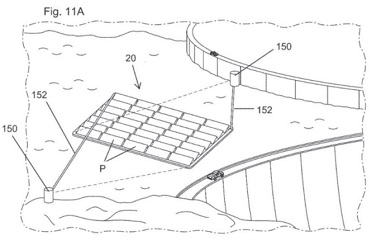
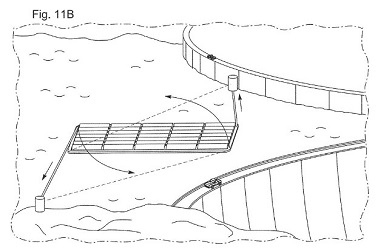
Image from: US10411643B2
An obvious drawback of such a system is the need for reservoirs of sufficient capacity to accommodate the solar platform and ensure its turn. This reduces the potential opportunities for using such tracking systems in water reservoirs having complex configuration and small size. In addition, increased requirements are imposed on devices for fixing the floating platform on a large body of water, especially in adverse weather conditions.
Another group of technical solutions offers single platforms with solar panels placed on floating objects. In this case, the regulation of the orientation of the panels relative to the sun is carried out by means of mechanical drive devices. An example of such a solution is proposed in Taiwanese patent TWI697646B Floating solar panel solar tracking system.
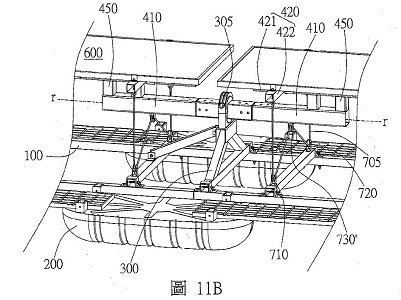

100 – Base; 200 - Floating device; 300 - Support group frame; 305 – Bearing; 422 - Branch bracket; 500 - Drive device; 600 - Solar Panel
Image from: TWI697646B
The invention states "…the present invention provides a floating solar panel solar tracking system including a first solar panel solar tracking module. The first solar panel solar tracking module includes a base; a floating device connected to the base and configured to provide buoyancy; a support frame, wherein the bottom of the support frame is connected and fixed to the base, and the support frame includes a bearing at the top; a loading frame having a rotary shaft portion and a loading portion linked with the rotary shaft portion and configured to receive at least one solar panel, wherein the rotary shaft portion passes through the above bearing; and a driving device disposed and fixed on the base. The driving device is configured to drive the rotary shaft portion to rotate about a predetermined axis of the bearing, so as to interlock the loading portion to move the main orientation of the at least one solar panel".
Another patent document from this group proposes a similar variant in terms of the location of the tracker mechanism: WO2020198618A1 Floating solar tracker. In the description of the patent application, the authors specify: "Systems are described herein to include a floating solar tracker. A floating solar tracker includes solar panels, a mechanical structure, and a floating structure. The solar panels are supported by mechanical structure that is secured to floating structure. The floating structure can be a pontoon-like structure that includes a pair of hollow cylinders. The hollow cylinders can be cylinder structures having a positive buoyancy to facilitate floating on a body of water. The mechanical structure can be secured to floating structure via an anchor band. In some variations, a reflective material can be stretched on top of the floating structure so as to maximize the amount of light reflected back to the solar panels".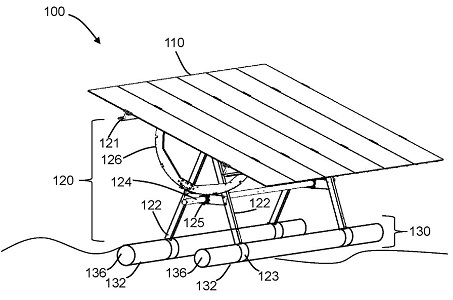
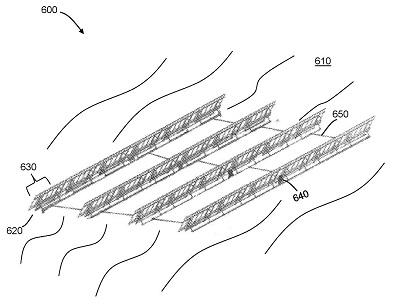
100 - floating solar tracker; 600 - system of multiple floating solar trackers coupled together and arranged in rows
Image from: WO2020198618A1
It is known that the reliability and maintenance of tracking mechanisms, even in ground conditions, is of concern to maintenance personnel, the more it will be difficult on floating objects. This is one of the main disadvantages of this group of technical solutions.
In the next group of technical solutions, the orientation of solar panels is proposed to be carried out by injecting liquid into the cavities of the supporting platform. For instance, such variant is proposed in patent US8921682B2 Photovoltaic system able to float on water and track sun.
A buoyant photovoltaic tracker system is proposed in the invention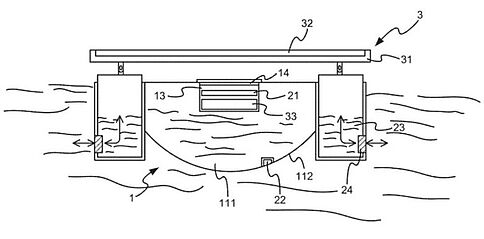 . The system comprises a chamber and four sleeves, one on each of the corners of the system. The chamber is buoyantly supported by water and can be partially flooded as ballast by an adjusting mechanism that includes a control unit and a valve. The system further comprises four buoys, one in each of the sleeves and four pumps to adjust the amount of water ballast in each of the buoys, thus controlling the tilt angle of the adjusting mechanism. The photovoltaic system is positioned on the four buoys and tilts correspondingly to the mentioned tilt angle. The authors claim that the invention solves the problems of the prior art by improving the abilities of the system to face the sun for more efficient power generation.
. The system comprises a chamber and four sleeves, one on each of the corners of the system. The chamber is buoyantly supported by water and can be partially flooded as ballast by an adjusting mechanism that includes a control unit and a valve. The system further comprises four buoys, one in each of the sleeves and four pumps to adjust the amount of water ballast in each of the buoys, thus controlling the tilt angle of the adjusting mechanism. The photovoltaic system is positioned on the four buoys and tilts correspondingly to the mentioned tilt angle. The authors claim that the invention solves the problems of the prior art by improving the abilities of the system to face the sun for more efficient power generation.
Image from: US8921682B2
In one of the most recent patent applications WO2020165272A1 Floating solar tracker, a more complex option for adjusting the angle of inclination of solar panels by injecting water into the support cavities is proposed: "A solar tracker float assembly extending along a principal longitudinal rotational axis and comprising at least one floating tube element extending along and/or parallel to said principal axis and having at least one internal cavity, at least one array of photovoltaic solar modules oriented at an angle with regard to said principal longitudinal axis and rigidly connected to said support tracker assembly, and a control system comprising pumping means and an electronic controller arranged to control said pumping means to inject or withdraw water and/or air inside said internal cavity in order to rotate the floating tracker assembly about said principal axis between a maximum right directed position and a maximum left directed position".
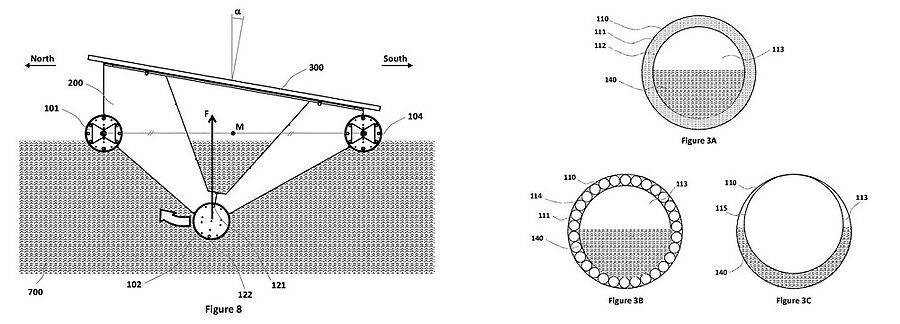
300 - photovoltaic solar modules
Image from: WO2020165272A1
According to the authors, hydraulic control systems make it possible to control large arrays of solar panels at minimal cost. However, it is also clearly seen that the proposed technical solutions in this group are not simple, and therefore will require appropriate budgets. For many investors, proven, much cheaper and more reliable fixed solar panel systems may be more acceptable, especially since the potential benefit from using solar trackers is relatively small and has yet to be achieved.
Thus, each of the three revised groups of structures for adjusting the orientation of floating solar panels has its own advantages and disadvantages. Obviously, it is impossible to obtain a universal and dominant technical solution here – much depends on specific environmental conditions, the production experience of personnel, regional traditions, financial capabilities, advancement of business owners, etc. In this regard, it is the variety of proposed technical solutions that can serve as the basis for promoting solar trackers on the electric power industry market.
A complete version of the Solar Trackers. Extended patent report. June 2022 can be found at www.aenert.com
